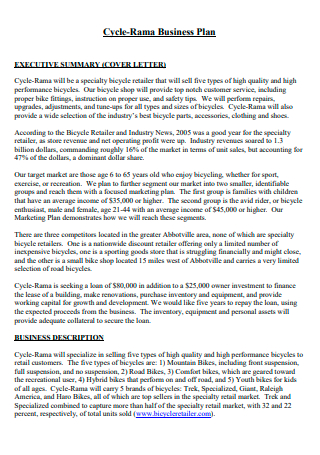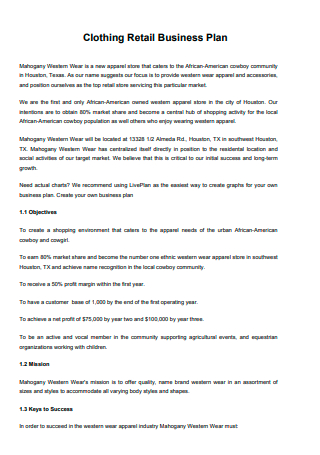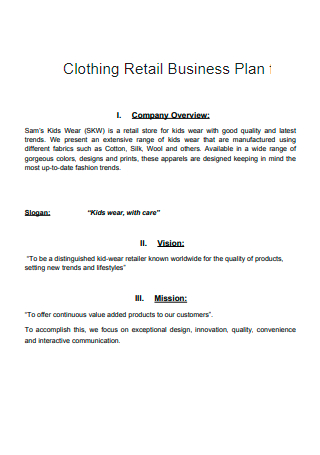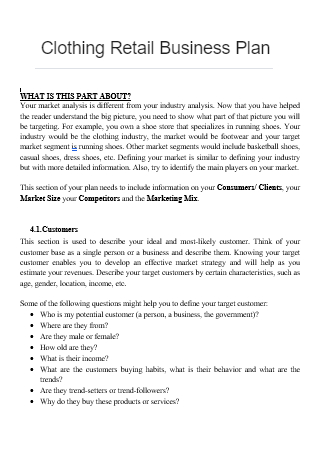4+ Sample Clothing Retail Business Plan
FREE Clothing Retail Business Plan s to Download
4+ Sample Clothing Retail Business Plan
What IS a Clothing Retail Business Plan?
Advantages of Having a Retail Store
Making the Clothing Retail Business Plan
FAQs
What are some of the barriers to entry for a clothing retail business?
What are the common types of retail stores?
What are some of the commonly practiced pricing strategies in the market?
What IS a Clothing Retail Business Plan?
A clothing retail business plan is a documented process on how retail stores go about accomplishing their operational, marketing, and financial goals in the clothing business. Retailing is at the end of the distribution supply chain. Retailers typically buy a large volume of products, in this case, clothes, direct from manufacturers to be sold at their store outlets. There is a direct relationship between the manufacturers and the retailers since retailers need manufacturers to fill up their stores and manufacturers need retailers to be a distribution point where customers can purchase their products. You have your Macy’s, Bloomingdale’s, Nordstrom, and even Sears, all carrying different clothing brands to be sold in their stores. A business plan provides the concrete steps needed to carry out the marketing and sales strategies and oftentimes is also used as a report presented to secure funding from investors, or in this case, secure more manufacturers to be part of their retail store business.
Advantages of Having a Retail Store
There is no denying the important role retail stores play in a business’s supply chain operation. Retail stores buy products directly from manufacturers or wholesalers, and then take a fixed percentage profit by selling those products to consumers. Retail stores have come a long way in the business of buying and selling goods or services. From barter trades to market bazaars, outlets, shopping malls, or department stores, even now the current trend of online retail stores, although retail stores remain a traditional method of distribution, nevertheless, still an effective method of the selling strategy. The following are some of the advantages of having a retail store business.
Making the Clothing Retail Business Plan
A clothing retail business plan is a roadmap, a guide of how the clothing retailer achieves its business objectives or goals. It could be business operational goals, marketing goals, or financial goals. Business plans are also used as a document presented to secure additional funding or attract potential investors, especially if they are a start-up business. There are no hard and fast rules when it comes to making a business plan. A business plan should be flexible enough to suit the business’s requirements. At most, to have an effective clothing retail business plan, the following essential elements should be included.
-
1. Executive Summary
An executive summary is a summary of all the business plan’s key points in achieving the business’s goals. An executive summary in a clothing retail business plan contains a brief background of the business, an explanation of the purpose or the need of the business plan, and/or what are the clothing retail business’s goals or objectives. Executive summaries often contain a mission and vision statement. A mission statement states the retailer’s purpose for having the business plan. It also reflects the company’s culture and values. Levi Strauss & Co., or Levi’s, mission statement go “To sustain responsible commercial success as a global marketing company of branded apparel.” A balance of sustainability and commercial success is at the core of Levi’s culture, and, with this mission statement and their consistent success for decades, they have achieved their mission. A vision statement gives a depiction of what the clothing retail company hopes to achieve, usually in a given timeframe. Macy’s, an American retail chain company, is one of America’s largest department store companies in terms of retail sales revenue. Their vision statement goes “to operate Macy’s and Bloomingdale’s as dynamic national brands while focusing on the customer offering in each store location.” Macy’s vision statement reflects the company’s focus on customer experience and the company’s position in the market. Their statement proved to be powerful, which is why the company is at the success where it is right now. And which is what a vision statement should be. A vision statement should set the tone of the company’s business plan. It should inspire and motivate both the owner and the employees to work together in achieving the company’s goals.
-
2. Products and Services
This is the part where the clothing retail company describes the products and services it plans to offer, including its pricing strategy, product lifespan, and what are the benefits the customers can gain from purchasing their products or availing their services. Products are, obviously, the different clothing brands. The business plan could also describe why the company chose to partner up with those specific manufacturers. Services could be a call, order, and pick-up service and/or seasonal promos and discounts.
-
3. Market Analysis
A market analysis studies the condition of the clothing retail market. It analyzes if there is a current need in the market for a clothing retail business, studies its target customer market, as well as analyzes existing competitors. One way of understanding the target market is to do a demographic analysis or a classification of customers. Customers are classified according to their age, gender, lifestyle, income, location, culture, affiliation, et cetera. Doing a SWOT analysis is also another way of understanding the market. SWOT is the clothing retail business’s Strengths, Weaknesses, Opportunities, and Threats. Strengths could be those factors that make the business stand out. It could be that the retail store is known for selling luxury clothing and apparel. Or it could be that the store is known for its good customer service experience. Weaknesses are those factors limiting the business’s success or those that need to be improved. Some of the weaknesses are lack of funds, lack of clothing expertise, lack of personnel, and so on. Opportunities are those factors that the clothing retail business can leverage to help accomplish its goals. Examples are using online platforms, social media, or social networking sites as part of their marketing strategy, or hiring influencers or celebrities to promote the clothing retail company. Threats are those factors that could potentially harm the business and its operations. The factors could be an increasing presence of competing clothing retail stores in the area, expensive cost of startup or excessive and strict requirements, and/or inaccessibility of store location from manufacturer’s delivery.
-
4. Marketing Strategy
Marketing strategy is all about how the company will position itself in the market, and how it will reach its target market. It also includes the advertising and marketing campaigns of the company to drive sales and attract more customers. Marketing strategies should always be anchored on the company’s mission and vision, as well as its goals and objectives. One marketing strategy is creating an attractive and appealing logo design or slogan. The logo should be catchy enough that it instantly appeals to its target market. The logo should also reflect the culture and values that the clothing retail company stands for. Another marketing strategy is making an online presence through website creation and SEO marketing. SEO, or search engine optimization, is the ranking of the company’s website to make it the number one top search website. Another strategy is hiring influencers or celebrities to promote the clothing retail company. They could act as brand ambassadors or be models or actors in a commercial for the company. Another marketing strategy is franchising. If the clothing retail company was able to achieve its financial goals, franchising is another way of further conquering the market. Franchising could leverage the company’s presence further in other locations, broadening its customer scope.
-
5. Financial Planning
The financial planning section is all about how the company can afford to accomplish its goals. A business plan is all about numbers, the funds needed to finance the marketing strategies, as well as to pay the company’s operating expenses. Investors often look forward to this section of the business plan. This is where they determine if the planned strategies are feasible, measurable, and achievable enough and if their investment will be growing along with the company. If funds are needed, then the financial planning section provides details of where and how the funds will be spent. This section typically includes the cash flow statement, balance sheets, and even financial projections. A cash flow statement presents the capital vs cost and expenses, while a balance sheet includes the company’s assets and liabilities. Financial projections are often based on marketing strategies. These are predictions or revenue projections that can be gained from each strategy.
FAQs
What are some of the barriers to entry for a clothing retail business?
One barrier to entry for a clothing retail business is the expensive capital startup requirements. Capital requirements are the number of funds needed to start a business, which usually consist of the infrastructure cost, the operational cost, management, and administration cost, marketing campaigns cost, utilities and maintenance, et cetera. Another barrier is the store space location. This could be due to the unavailability of space in strategic locations. Existing competition loyalty is another barrier to entry. Lack of technological knowledge in online digital platforms or software is also another barrier to entry.
What are the common types of retail stores?
One type of retail store is the convenience store. Convenience stores are typically found within residential areas. Although convenience stores have a limited product range, still, the products sold at convenience stores are usually the type of products that are part of people’s basic needs. 7-Eleven is a good example of a well-known convenience store. A department store is also another type of retail store. Considered as the biggest type of retail store, department stores offer the widest range of products to choose from. Typical examples would be Macy’s, Bloomingdale’s, and Kohl’s. Supermarkets are also one of the common types of retail stores, and perhaps the most common there is since you can find supermarkets almost in any corner of any locale. Another type of retail store is the drug store. Specially made for pharmaceutical purchase purposes, drug stores have also evolved over the years, with the inclusion of having their convenience store within a drug store.
What are some of the commonly practiced pricing strategies in the market?
Having a good pricing strategy is an important part of any marketing plan. Prices are often computed based on product value in production, the supply, and resources used, as well as the labor that went through the creation of the product. One pricing strategy is called price skimming. Price skimming is setting a high price on a product, especially for new products, and then lowering the price over time as more competitors enter the market. Premium pricing is also another pricing strategy usually for high-quality products, targeting high-income customers. Another strategy is the market penetration strategy. Market penetration is the opposite of price skimming. Products are introduced at a low price to undercut competitors, and gradually increase the price when the customer base is established.
As part of a good marketing strategy, clothing retailers would jump at the opportunity to sell well-known brands, leveraging on the brands’ popularity and existing customer base. But more than that, clothing retail businesses need to have a roadmap on hand, a guide that will lead through taking the next appropriate steps to keep the business running, and eventually, accomplishing its goals and objectives. What they need is a good and effective clothing retail business plan.
Don’t know where to begin to start your clothing retail business? Worry no more! Download our clothing retail business plan templates now, and start taking those steps towards a successful retail business!





